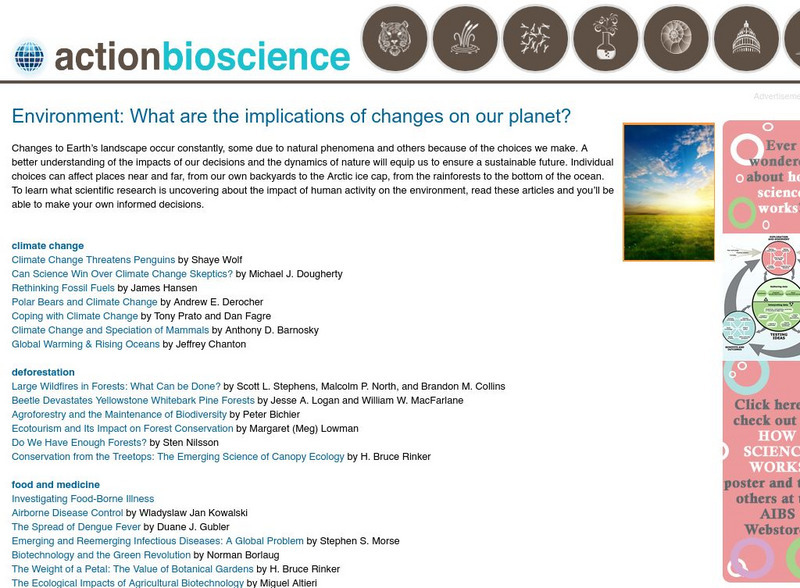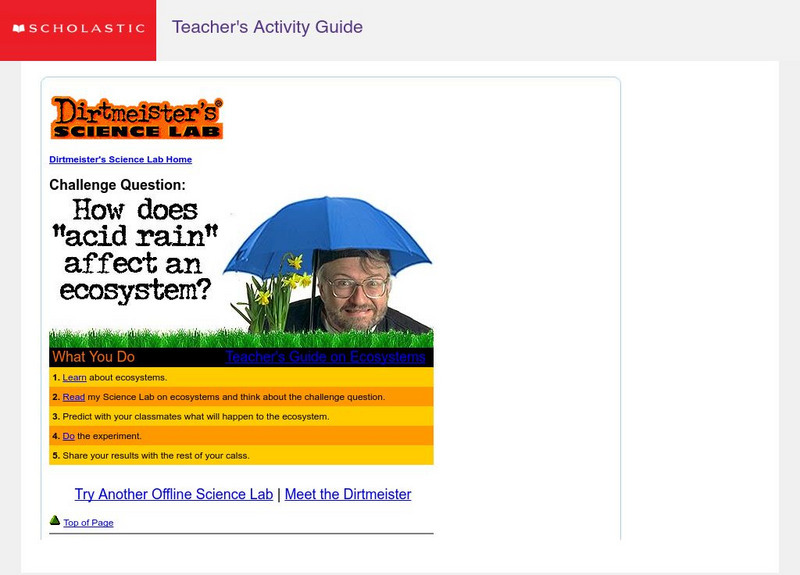McGill University
Mc Gill University: Canadian Biodiversity: Ecozones: Arctic Archipelago Marine
The Arctic Archipelago Marine ecozone includes Hudson Bay and most of the water surrounding the islands of Nunavut and the Northwest Territories. This is a brief, concise description of the location, climate, geology, and flora and...
Ducksters
Ducksters: Science for Kids: Tropical Rainforest Biome
Kids learn about the tropical rainforest biome. This diverse ecosystem produces much of the Earth's biodiversity.
Ducksters
Ducksters: Science for Kids: Taiga Forest Biome
Kids learn about the taiga forest biome. The largest of the land biomes is known for its evergreen trees.
Ducksters
Ducksters: Science for Kids: Savanna Grasslands Biome
Kids learn about the savanna grasslands biome. This tropical ecosystem is full of large herbivores like zebras, giraffes, and wildebeests.
Ducksters
Ducksters: Science for Kids: Tundra Biome
Kids learn about the tundra grasslands biome. This cold and dry ecosystem is located far to the north.
Ducksters
Ducksters: Science for Kids: Temperate Forest Biome
Kids learn about the temperate forest biome. Four distinct seasons and lots of trees.
The Environmental Literacy Council
Environmental Literacy Council: Ecosystems
Article explaining ecosystems and why we use them to organize our ideas about the natural world. Links to additional resources, maps, and activities.
Discovery Education
Discovery Education: Habitats of the World
This site has a lesson to use to start a unit on biomes and animal habitats. This plan incorporates grasslands, temperate forests, tropical rainforests, deserts, polar ice regions, and tidepools.
Utah Education Network
Uen: Utah's Plants and Animals Do You Know Where I Live?
Can you figure out what types of biomes different organisms belong in? You'll be presented with a variety of organisms and asked which of three biomes they belong in.
Science Struck
Science Struck: Facts About Freshwater Biome
Describes the characteristics of a freshwater biome, the climate, and the animals and plants that live there.
Thomas Jefferson National Accelerator Facility
Jefferson Lab: Where Plants and Animals Live
Read and fill in the blanks of this passage explaining habitats where plants and animals live. Each blank has a dropdown menu with choices. When you finish, click CHECK MY ANSWERS. If you pick a wrong answer, the right answer will be...
Missouri Botanical Garden
Missouri Botanical Garden: Biology of Plants: Plant Adaptations
Read about how plants adapt to survive in different biomes. Includes a song, game, photos, and lesson plans.
National Earth Science Teachers Association
Windows to the Universe: Climate Changes With Latitude
A map showing the division of the world into eight biomes based on different climate types around the world. There are links to more information about each biome.
American Institute of Biological Sciences
Action Bioscience: Issues in Environment
This site from American Institute of Biological Sciences provides a collection of articles on current issues in environmental science and human impacts on the environment. Several articles available in Spanish.
PBS
Nh Pbs: Nature Works: Swamps
What characteristics make a swamp a swamp? This site features information on the Great Dismal Swamp, Conifer Swamps, Okefenokee Swamps, Shrub Swamps, Hardwood Swamps, and Cypress Swamps. This site also offers some great photographs of...
Alabama Learning Exchange
Alex: Abc Book of Fauna
This lesson is to provide students the opportunity to explore the various types of fauna (animals) found in the various biomes throughout the world.
Scholastic
Scholastic: Dirtmeister's Science Lab: Acid Rain
Step into Dirtmeister's Science Lab as he sets out to answer the challenge question: "How does acid rain affect an ecosystem?" Learn about ecosystems, make your predictions and then do the experiment.
Alabama Learning Exchange
Alex: Where Does Our Waste Go?
In this lesson from "The Friends of Auntie Litter", (www.auntielitter.org), waste disposal will be explored. The Pollution Patrol follows the steps involved in trash disposal, starting with a girl tearing a sheet of paper out of her...
E-learning for Kids
E Learning for Kids: Science: Pacific Ocean: What Can We Find on a Beach?
Josephine lives on the Marshall Islands. Follow her to the beach and find out what kinds of plants and animals live there.
E-learning for Kids
E Learning for Kids: Science: Caribbean Sea: Pirates: What Are Some Common Habitats?
Pete is shipwrecked and exploring environments around him. Want to join him as he learns about plant and animal habitats?
Science Education Resource Center at Carleton College
Serc: Discovering Nature in Our Neighborhood: Investigating Natural Communities
Students examine the natural surroundings around the school and identify micro-communities of plants, insects, and other animals through walks and nature journaling.
Ducksters
Ducksters: Science for Kids: Desert Biome
Kids learn about the desert biome. The dryest areas on Earth still have plant and animal life.
Other
The Ecosystems Center
A resource with educational information on ecosystems, as well as programs that focus on environmental research and education.
ClassFlow
Class Flow: Ecosystems
[Free Registration/Login Required] This flipchart explores the different ecosystems of the world, enhanced by embedded videos showing both the landscape and the plants and animals that can be found there.






















